Once again about the dominant gene of blue eyes
in the cattery Ermine Trace
Elizaveta Lipovenko, 2021
I. A little history: how it all began
I consider the birth-date of the breeding line founder, 12 October 2016, to be the beginning of my work with the dominant blue eyes gene (DBE) in our collective nursery. Since then, the colours determined by this and similar genes have suddenly become very popular and in demand, so we are often asked questions about where the gene came from, how it is inherited, how it behaves, and what to expect from it. Below I will try to answer some of these questons.
We have never really used any other cats in our DBE work other than purebred British chinchillas. We’ve never caught a blue-eyed or odd-eyed house-cat at night, never turned to Nikital or other friendly catteries to acquire a Topaz or Altai cat in order to secretly interbreed these to get a new commercial colour. And at that time, it was not a commercial prospect. In 2016, not only were blue-eyed British cats without white or with a minimum of white, not recognized by any registry, there were very few people interested in them at all. We, too, were not interested in the trait, so we had planned completely different breeding programmes: colourpoint, chocolate, long-haired and certainly nothing experimental that involved working with cats of unrecognized colours.
But fate decreed otherwise. From a normal pair of British Shorthairs - green-eyed silver shaded female Ermine Trace Olwen (BRI ns 11) and silver shaded colourpoint male Schoenweg Teodoro (BRI ns 11 33) - was born Ermine Trace Nadeya (ns 11 61) - a silver shaded cat with not green, but blue eye, like a colourpoint. This was not the first time that Nadeya's parents were bred. By that time, the male had already sired about 40 offspring: gold and silver, colourpoints and ordinary chinchillas. All these kittens were normal British chinchillas, without any oddities. And although he was imported (acquired from the Austrian Schoenweg cattery, well-known to any chinchilla breeder), the mother was bred by ourselves, and we had personally seen almost all of her ancestors. We repeatedly used inbreeding in our programme, and that way we never produced any "unusual" kittens, but exclusively produced British chinchillas in only the recognized colours.
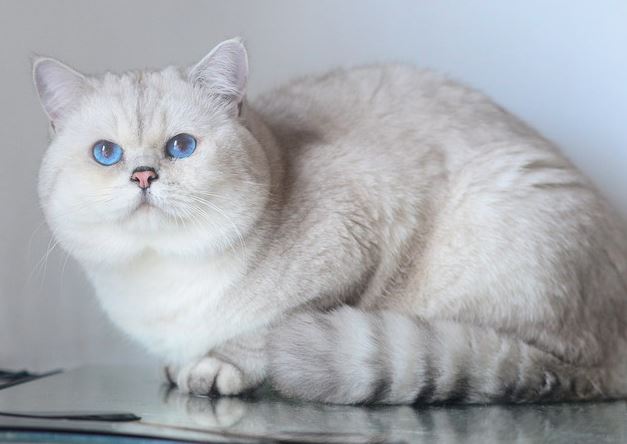 |
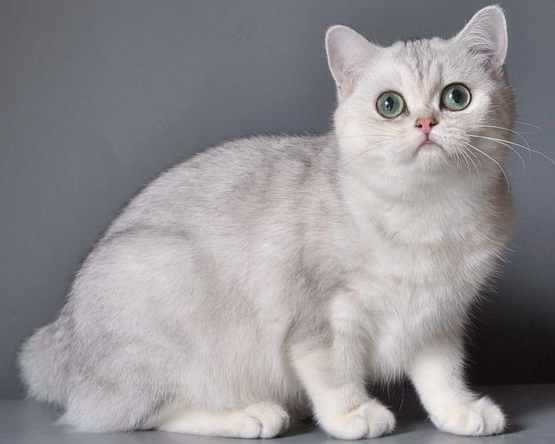 |
| The father of Nadeya (and of 38 "normal" kittens without signs of DBE), Schoenweg Teodoro, is colourpoint and, therefore, the main "suspect" as a hidden carrier of DBE. In the 3-4th generation pedigree he has a Selkirk Rex, Ali G. von den Lauselümmeln (SRS ns 11 33). However, at least 4 generations of Ali G’s ancestors are known, and except for colourpoints there are no blue-eyed or odd-eyed cats. In the Selkirk Rex breed, all colours are allowed and breeders would have had no reason to hide anything. | Nadeya's mother, Ermine Trace Olwen. All her ancestors are purebred British chinchillas from the well-known Burgersruh, Goldenen Winkel, Wahrberg, and Schoenweg catteries. Ther is repeated inbreeding in her pedigree – generations II-III, III-IV, IV-IV. Olwen is a green-eyed black-silver chinchilla, genetically marbled, and without any oddities. IN total her mother had five kittens, born in three litters, and except for Nadya, all are normal: no white and no "wrong-colour" eyes. |
At first, Nadeya also seemed ordinary, except perhaps for the asymmetrical nose outline, which I did not pay much attention to. I did not plan to keep this female in the cattery; the vast majority of chinchilla breeders no longer worked with silver and had switched to genetically ticked golden, so this genetically spotted ns 11 (black-silver) cat seemed to be an unpromising breeder. When she was about two months old, I noticed her unusually light eyes and thought that they would become a pale, unattractive green colour, maybe eventually yellow. So Nadeya had every chance of becoming a happy pet, especially since, in addition to her " pale, unattractive" eye colour, she also had a pink toe on her hind paw. For many experts, this is a good reason to immediately suspect a tortoiseshell chinchilla - fs 11.
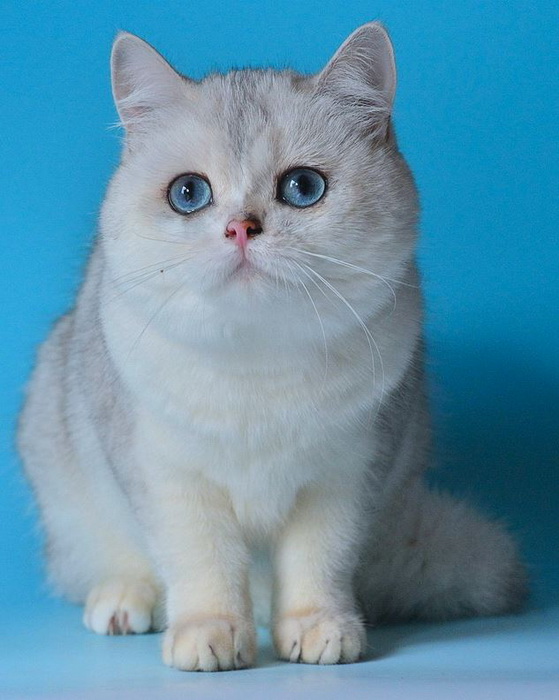 |
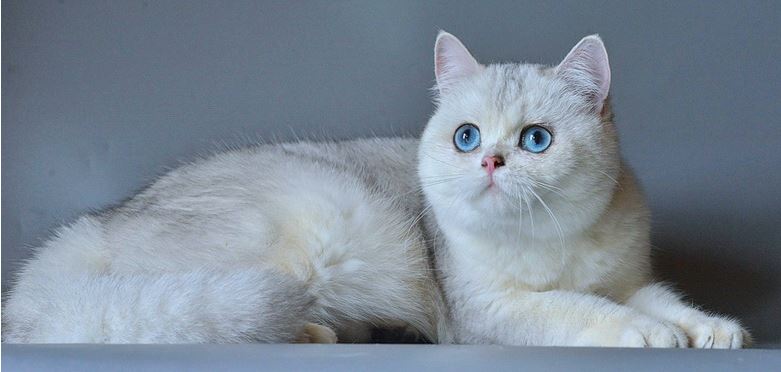 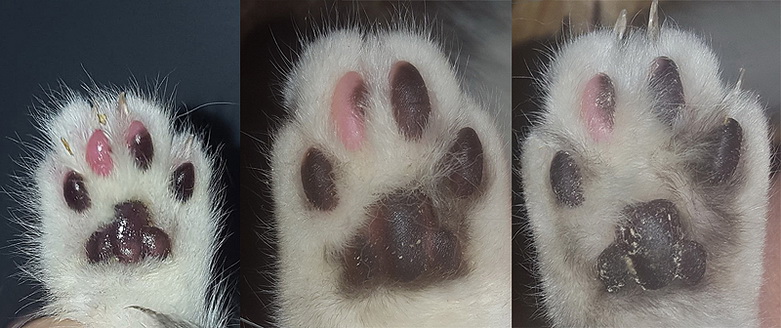 |
| Nadeya herself, and the signs of the presence of white in her colour: an asymmetrical nose outline and a pink toe on her hind paw in childhood, adolescence and adulthood. | |
However, the expected pale, unattractive green eye colour did not appear. Instead, Nadeya's eyes began to take on a bright, rich blue colour. It was now impossible not to consider colourpoint-related blue eyes and that camera flash makes them glow red, and to try to take several photos with a flash. Nadeya's eyes lit up really red, which is impossible for black silver chinchillas.
And yet, still nobody even thought about any DBE genes! I showed off my "strange" cat on Facebook and my associates suggested that Nadeya was a hidden colourpoint with a strange colour. To confirm or deny this, a gene test was performed on her. Nadeya was a direct descendent, therefore a carrier, of colourpoint (remember, her father was ns 11 33 - silver shaded colourpoint), and the genetic test confirmed this, but Nadeya herself was not colourpoint. Her genotype turned out to be Ccs, meaning not colourpoint, but a carrier of a single copy of the recessive colourpoint gene.
After receiving the results of the gene test, we naturally assumed that Nadeya had inherited some other recessive genes that were passed down many generations, hidden until two carriers accidentally met. They had produces a kitten homozygous for that recessive and there was a "segregation" kitten with an unusual phenotype, as happened in due course to produce chinchilla-point kittens.
I really liked this assumption. Because by that time I had already learned enough about the DBE genes, for example, those that were the basis for breeds such as the American Ojos Azules, the Altai cats and the Topaz. I was not happy about the properties of these genes because, in their manifestation and the principles of working with them, they were like the complex Fd gene, which is responsible for the folded ears of Scottish Folds. All these genes are pleiotropic, that is they act upon multiple traits and instead of determining a single desired trait they affect several at once, including some that are extremely undesirable. Also, these genes have variable expression, i.e. sometimes the gene is present but manifests so weakly that it can be overlooked. Finally, the transition of these genes from heterozygous to homozygous state can lead to various deformities and even death of kittens.
We already worked with Scottish Folds and were not ready for another "complex" gene. In this sense, a recessive gene for blue eyes was more desirable. After all, this would mean we owned a homozygous cat, and only needed to carry out a few simple crossings to get a homozygous male, mate both homozygous cats together and immediately achieve litters that were 100% blue-eyed. This would be exactly the same way we achieved the chinchilla colourpoint some time ago.
Unfortunately, we didn’t entertain hopes of a newly emerged, unknown recessive gene for long. To date, multiple mating of both Nadeya herself and of her blue-eyed and odd-eyed descendants with completely unrelated mates (no common ancestors) irrefutably proved that the gene for Nadeya's blue eyes is dominant. And, unfortunately, it is very similar in its properties to the Ojos Azules gene, the Altai gene, the Topaz gene, and the genes of other DBE cats known today.
II. Our DBE cats: past, present and future breeders
During 5 years of work, we saw born almost all variants of the DBE phenotype which we had heard about from more experienced associates working with the Altai gene and the Topaz gene. I will show you some of them.
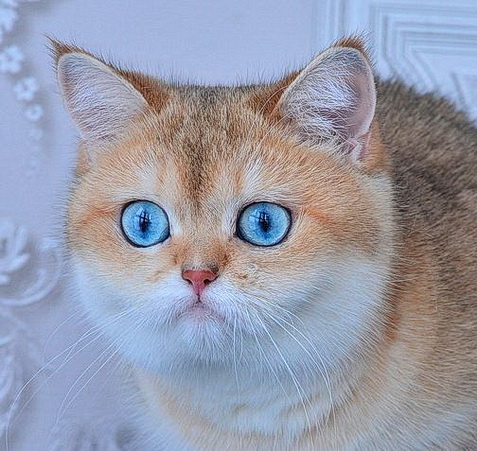 |
Ermine Trace Zarafina, granddaughter of Nadeya, - BRI ny 11 61 (blue-eyed) without visible white. A fairly large, bright golden, beautiful cat. She gave birth to her first kittens. She was mated with another DBE heterozygous cat in the expectation of obtaining homozygotes, which are necessary for a successful genetic study and without which information about our DBE will be incomplete. There are three kittens in the litter and one of them is golden blue-eyed. |
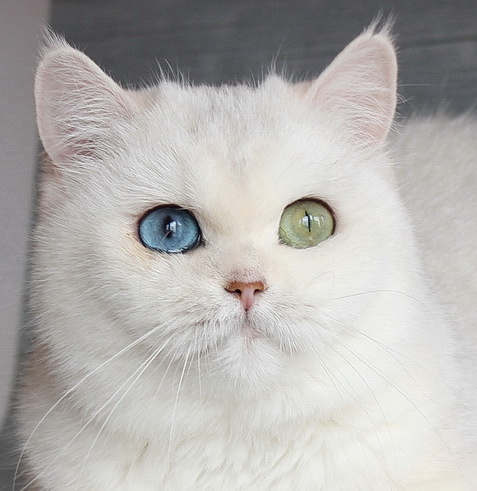 |
Ermine Trace Enya, daughter of Nadeya, BRI ns 11 63 (odd-eyed) with no visible white. She has already given us several litters from unrelated cats, in each of them at least one kitten obviously has DBE. |
 |
Ermine Trace Hermes, BRI ns 12 63 has a little white. This is a photo of him as a juvenile. Hermes has a sectoral heterochromia of the left eye - this eye has a small area of non-blue colour, there was no red glow from it from the very beginning. He is the son of Enya and an unrelated cat, Ermine Trace Qorall BRI ny 12. |
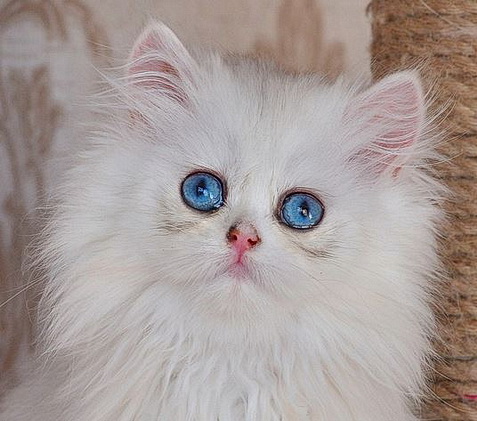 |
Ermine Trace Metelitsa, BLH ns 11 61 has a small amount of white (a triangle on the muzzle is clearly visible, but there are no pink toes). This is a photo of her as a kitten. Born from two DBE heterozygotes, theoretically she could be homozygous, but she does not have any specific signs such as deafness. We will check for homozygosity by mating and, if possible, by gene tests. |
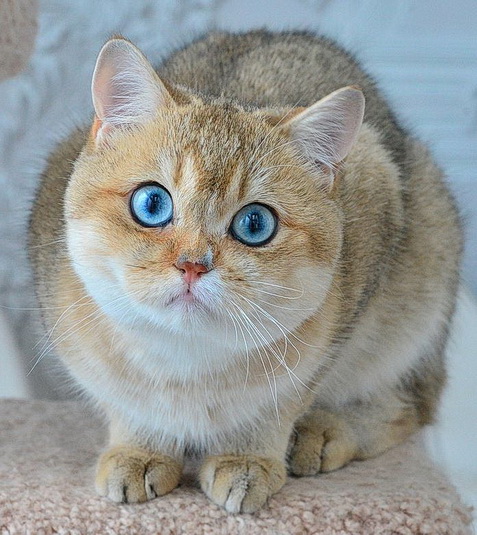 |
Ermine Trace Jantar, BRI ny 11 61 has a little white (stripe on the nose, left pad). This is a photo of him as a juvenile. He is especially valuable for us because, unlike most of our cats, he does not carry the colourpoint gene. The frequent birth of colourpoint kittens, which are blue-eyed, greatly complicates our work with DBE, so we are gradually removing colourpoints and colourpoint carriers from our breeding lines. It was not possible to do this immediately because the foundation female is a colourpoint carrier. |
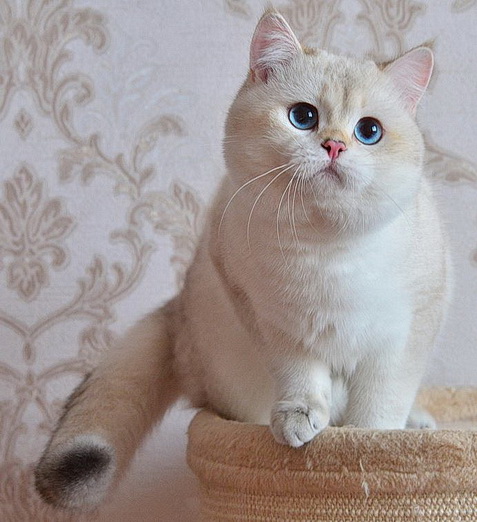 |
Ermine Trace Xrustal, BRI ny 11 33 without white, DBE heterozygote, Nadeya's son, born from a mating with an unrelated cat. He was one of those colourpoints that one after another must leave our nursery, and with whom it was especially difficult for us to part. He left with us being completely confident that he had not inherited the DBE gene, so his daughter Lemniscata – a latent (hidden) DBE heterozygote – came as a complete surprise. There was nothing unusual in Xrustal’s appearance - no white, nor any oddities in colour, set, shape of eyes, or facial structure – as a clue. As a result, mating DBE to DBE in order to obtain homozygotes happened earlier than we expected. |
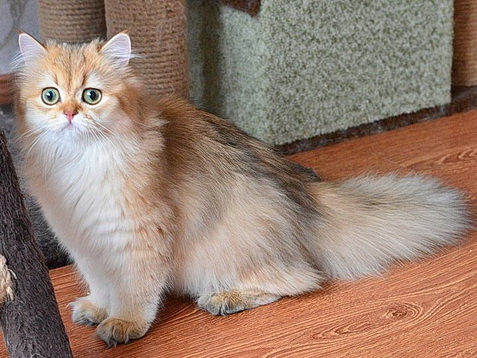 |
Ermine Trace Lemniscata, BLH ny 25 without any white is a latent [has the DBE gene but does not have blue or odd eyes]. Her eyes glowed red in childhood, then stopped glowing red. This is a photo of her as a juvenile. She was born from mating Xrustal to a half-sibling (Witch) without DBE. It is usually said that only latents can be obtained from breeding latents together. So let's check so that the fears of breeders who definitely do not want a hidden "carrier" of DBE in catteries become groundless. He would suddenly spoil all their breeding work by starting to regularly produce blue-eyed and odd-eyed kittens? |
 |
Sunny Blue Ermine Trace, Nadeya's great-granddaughter, BRI ny 11 61 with a little white (pink toes on her hind legs). It took a long time to choose between her and her litter-sister and make the difficult decision to keep only her sister. Thus, Sunny Blue is free and leisurely looking for serious, thoughtful associates ready to join in our research work and who are unafraid of the difficulties. |
 |
Santana Ermine Trace, BRI ny 11 61 without visible white, Nadeya's great-granddaughter, and Sunny's sister. She is a girl with great eye colour that will get even better in the future. She remains in our cattery for further study. |
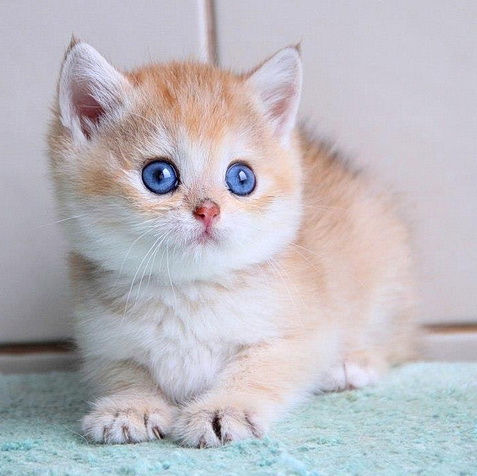 |
Tanatos Ermine Trace, BRI ny 11 61, has signs of white in the form of two pink toes on the hind foot. He is Nadeya's grandson, another kitten obtained as a result of mating DBE to DBE (Zarafina x Xrustal). He is still small and under observation and future will be decided later. |
 |
Urbi et Orbi Ermine Trace, BRI ns 11 63, no visible white. He is Nadeya's grandson and Nadeya's son, resulting from a close inbreeding of DBE to DBE (Nadeya x Xrustal). I will not give him to anyone! |
I would also like to say a few words to those breeders who cannot believe that our first DBE cat, Nedeya, was born in our cattery without the use of other breeds. In fact, we are far from the first to experience this and we are also not the only ones; such cats have been born before and continue to be born from time to time in other catteries, there are quite a few examples. However, even breeders who admit that the spontaneous appearance of such cats is possible, don’t accept the possibility of it occurring at this time and in this place. The fact that Nadeya was conceived and born in a cattery where the owner is interested in genetics is, in their opinion, no less than a miracle.
Fellow breeders, there are no miracles here. It was inevitable that something like this would happen sooner or later, and had it not been a cat with DBE, then something else equally interesting would have appeared. New genetic variants appear all the time, and it is possible that the one that you find today has appeared before, with another breeder. It was just that the other breeder was not interested, and the new trait did not promise instant commercial benefits, but it promised disqualification at cag shows. Therefore that other breeder did not want to work with the new trait. I rejected that approach.

Forward >>
(Attention! Few pictures, many letters!)


